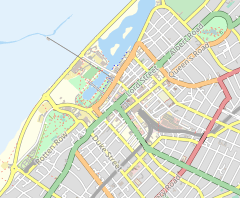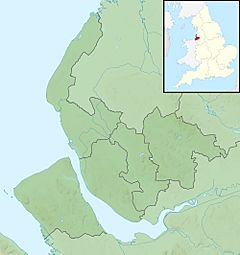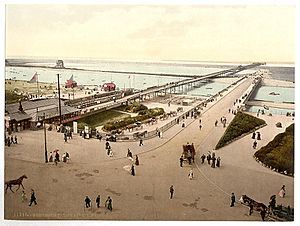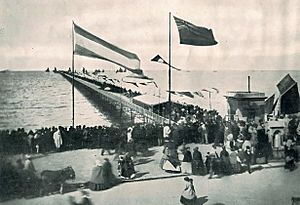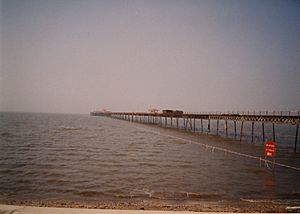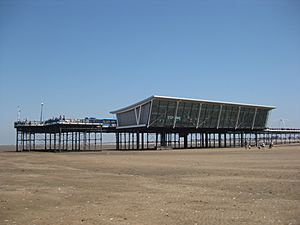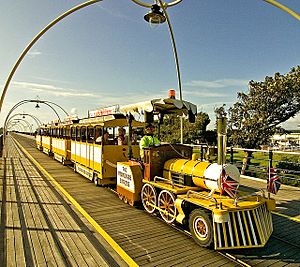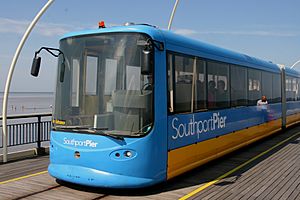Southport Pier facts for kids
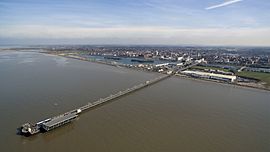
Southport Pier in 2016
|
|
| Type | Pleasure |
|---|---|
| Carries | Pedestrians |
| Locale | Southport |
| Maintained by | Sefton Council |
| Design | James Brunlees |
| Construction | W & J Galloway |
| Owner | Sefton Council |
| Total length | 1,108 m (3,635 ft) |
| Opening date | 2 August 1860 |
| Listed status | Grade II listed |
| Coordinates | 53°39′18″N 3°01′08″W / 53.655°N 3.019°W |
Southport Pier is a fun pier in Southport, Merseyside, England. It opened in August 1860 and is the oldest iron pier in the country. At 1,108 m (3,635 ft), it is the second-longest pier in Great Britain, after Southend Pier. In the past, it was much longer, but storms and fires in the late 1800s and early 1900s made it shorter.
Famous entertainers like Charlie Chaplin performed here in the early 1900s. In its early days, steam boats visited the pier. However, by the 1920s, mud and sand built up in the water. This made it hard for boats to reach the pier, and the service stopped in 1929. The pier became old and broken in the late 1900s. By 1990, it was losing money, and repairs were very costly. The local council wanted to pull it down, but they lost by just one vote.
The pier was fixed up really well between 2000 and 2002. It opened again in May 2002. The Southport Pier Tramway used to run from Southport Promenade to the end of the pier. It stopped running in June 2015. The pier is a special old building, listed as Grade II since 1975.
Contents
Where is Southport Pier?
Southport Pier is the second longest pier in Great Britain. It is 1,108 m (3,635 ft) long. Because of silt (mud and sand) in the water, part of the pier now goes over land before it reaches the beach. This is because the silt has created new land under the pier. The pier starts at Promenade Road. It goes inland next to Princes Park, then crosses Marine Drive. It meets the beach about halfway along its length.
The area around the pier's land end, including the marine lake, was bought by the pier company in 1885. This happened as more people moved to the area and the pier was made longer in the 1870s. In the late 1920s, the council created a large area of new land on the beach. They built a town park there. This park has a lake, a miniature railway, and car parking. The pier is a seven-minute walk from Southport railway station. It is about 480 m (0.3 mi) away.
History of Southport Pier
Building the Pier in the 1800s
People first thought about building a pier in Southport in 1844. This idea came with a plan for a railway from Manchester. In 1852, a group was set up to help build it. After talks about what the pier would be used for, the Southport Pier company started in March 1859. They had £12,000 to begin. Building the pier was thought to cost £8,000, but it ended up being £8,700. Work started in August 1859. The main reason for the pier was for people to walk along it, not just for ships. So, it is known as the country's first pleasure pier.
A year later, on 2 August 1860, the pier officially opened with a big parade. It was 1,100 metres (3,600 ft) long. This made it the second-longest and the first iron pier built for fun in the country. Waiting rooms for boat passengers were added in the first few years. A tram pulled by a cable was put in by 1865. The pier was made longer to 1,340 metres (4,380 ft) in 1868. Different steam boats used it, including those from the Blackpool, Lytham and Southport Steam Packet Company. These boats went to places like Fleetwood and Llandudno.
Visitors had to pay a small fee to enter. This fee was quite high at first, 6d (about £2.75 today). This was to make sure only richer people could afford to go. As the 1870s went on, more ordinary people started visiting. So, the fee was lowered to 2d.
Storms often damaged the pier. Several storms caused harm to the pier's base and buildings in the late 1880s and early 1890s. A fire in September 1897 burned down the main building (pavilion). A new building opened in January 1902. It was bigger and better, with a hall for shows.
The Pier in the 1900s
From 1903, divers were a popular show. They would dive from the tea house roof many times a day. The most famous were Professors Osbourne and Powsey. Powsey often jumped off the pier on a bicycle! From 1906, the new building was rented out for many performers, including Charlie Chaplin and George Robey. After the First World War, the building was renamed the Casino. Its main attraction was dancing. This was a good time for the pier financially. It made a profit of £9,155 in 1913. It made an average profit of £6,750 each year during the 1920s.
By the early 1920s, mud and sand built up in the water. This created new land. It also became harder for steam boats to reach the pier. The boat service stopped completely in 1929. Profits went down during the Great Depression (a time when many people lost jobs and money). A big fire in July 1933 made things worse. It destroyed the pier head. The damage cost about £6,000 to fix. The Southport Pier Company could not afford this. They sold the pier to Southport Corporation (the local council) in June 1936 for £34,744.
The pier closed to the public during the Second World War. It was used to help find enemy planes flying towards Liverpool docks. Unlike other piers, it was not cut off from the land during this time. The pier did not open again until 1950. In June 1959, another big fire happened. It destroyed 460 square metres (5,000 sq ft) of the pier's floor. This made it shorter to its current 3,633 feet (1,107 m) length. For a while, it was the third longest pier. Sefton Council took over the pier in 1974. It was named a Grade II listed structure on 18 August 1975, even though it was falling apart. In 1983, £62,400 was given by the European Regional Development Fund to make the pier stronger.
The pier kept getting worse in the late 1900s. A storm in 1989 caused a lot of damage. Even though it was a special old building, Sefton Council wanted to pull down the pier in December 1990. This was because of the high cost of repairs. But they lost by just one vote. The pier was losing £100,000 a year. It would cost nearly £1 million to save it, plus £250,000 every five years for repainting. So, a charity was set up in 1993 to look after the pier. Money was found from different places in the years that followed to keep the pier running. In February 1997, £34,000 was given from lottery money. This was for a check-up on its structure. The check-up showed it was in bad shape and should be closed. In October 1998, the pier received £1.7 million from the Heritage Lottery Fund. This money was given to help fix it up and make it open to people.
Southport Pier Today: The 2000s
After getting old and broken, and then closing, work to fix the pier started in 2000. It was finished in 2002. The pier opened again in May 2002. The repairs cost £7.2 million, and it got a new tram. Fixing the pier was part of a bigger plan to improve the area. This plan included a new sea wall to stop floods, nice gardens around the pier, and a new £28 million Ocean Plaza shopping centre.
The pier today has an open design. It has new railings on old supports and a wooden floor. You can see the sea through the floor. Along the walkway, there are small signs with names on them. Local people paid for these to help raise money for the repairs. The new building at the end of the pier was designed by architects from Liverpool called Shed KM. It cost £1.2 million. This building has a cafe with big windows like an airport. It also has a collection of old-fashioned mechanical arcade games. These games use old pennies (from before 1971), which you can buy there.
In April 2017, plans were announced to give the pier a £2.9 million makeover. Two-thirds of the money came from the Coastal Communities Fund. This money will be used for fixes and new shops. The council also wants to repaint, fix machines, improve the building, and make it easier to get to the pier from the beach.
Southport Pier Tramway
At first, the pier had a line for luggage from 1863. This was replaced in 1864 when the pier was made wider. A tram pulled by steam was then able to carry people and their bags. The track was put down again in 1893. It got electric power in April 1905. The trams were rebuilt in 1936 when Southport Corporation (the council) took over the line. The pier closed during the Second World War. When it reopened, the tram did not, because the town no longer had the right kind of electricity.
The tram line eventually reopened in 1950. The track width was changed and moved to the side of the pier (it used to be in the middle). From 1954, new diesel trams called the Silver Belle ran. These were built by a local engineer, Harry Barlow, who owned the Lakeside Miniature Railway. The trams were replaced in 1973 with English Rose. This tram ran until the mid-1990s, when people weren't sure if the pier would stay open. The old Silver Belle trams were left to rot for some years. Then, they were moved to the West Lancashire Light Railway to be made into carriages.
When the pier was fixed up in 2002, a new 3 ft 6 in (1,067 mm) narrow gauge tram track was put in the middle of the wider pier deck. On 1 August 2005, a new two-part, electric tram car started service on this track. It could carry 74 people. The tram ran every day of the year except Christmas Day. It ran every 30 minutes in both directions.
In July 2013, the tram service was stopped because cracks were found in the support poles. It stopped completely in June 2015. This was because it cost too much to fix and the council was saving money. It was replaced by a longer version of a smaller train that runs on land. The tram was taken away to be sold in March 2016.
Awards
- 2003 National Piers Society: Pier of the Year


